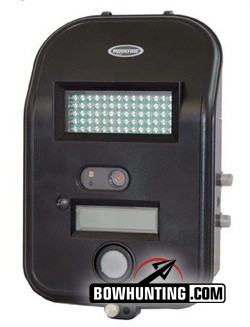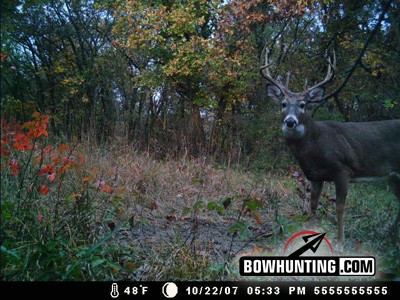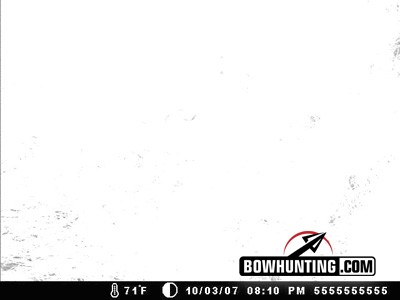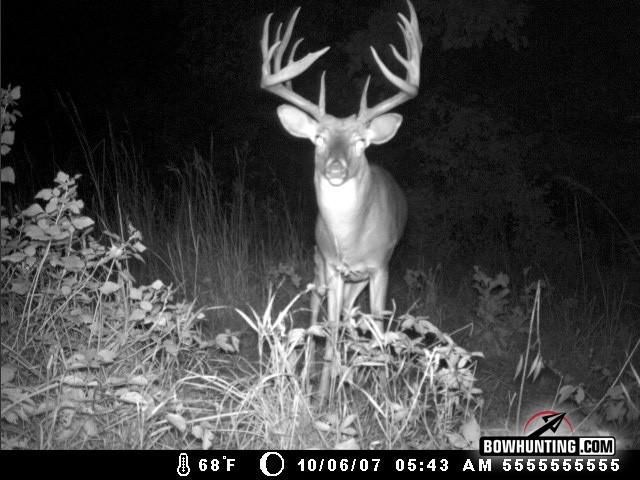LAST UPDATED: May 8th, 2015
 I wanted a camera that didn’t produce a visible flash. I have read many of the debates online about whether the visible flash spooks deer and I have talked to many friends who use flash cameras. Many of them feel the visible flash does spook deer. I reasoned that if the IR mode helped me photograph even one more buck on my farm that otherwise might have melted into the woodwork at the sight of the distant flash, it was worth the price.
I wanted a camera that didn’t produce a visible flash. I have read many of the debates online about whether the visible flash spooks deer and I have talked to many friends who use flash cameras. Many of them feel the visible flash does spook deer. I reasoned that if the IR mode helped me photograph even one more buck on my farm that otherwise might have melted into the woodwork at the sight of the distant flash, it was worth the price.
I selected the Moultrie Game Spy I-40 Infrared unit primarily because it is affordable (around $230 – $240) and has a nice four mega-pixel camera. It takes regular photos during the day and IR flash photos at night. Moultrie advertised some other neat features that I wanted, such as long battery life, quick trigger time and a laser aim that makes aligning the camera a snap.
I ran six I-40s on my land for three months last fall and got many images of great bucks. This review will detail what I learned.
SPECIFICATIONS
The camera has many very useful features. First, as mentioned, it has an infrared flash. The camera still has to produce a flash, but the flash is infrared, not visible white light.
It has an infrared sensor that detects changes in temperature in order to trigger the shot. It is not supposed to trigger on branch or grass movement. I got a lot of images of grass, but it is possible that the way I had the cameras set up there was a temperature gradient between sun and shadow and that was causing the extraneous shots. Either way, it was a bit annoying but not a major issue.
Moultrie advertises a 150-day battery life on these cameras and I can’t dispute that number. I had them out for 90 days and all of the cameras still show roughly 75% battery charge.
The I-40 has a 50-foot flash rating. Again, I would have to say their number is conservative. I have shots of deer that are at least 50 feet away. The camera didn’t seem to trigger on these long range deer, but they certainly appeared in the shot when the camera triggered on closer deer. I am not sure from looking at my photos what the maximum sensor distance is for the camera to trigger, but I don’t see any that were much beyond about 15 to 20 feet.
The camera accepts SD cards and as inexpensive as these have become, the SD is definitely the route to go.
The I-40 has a cool feature in which it prints the date, temperature, time and moon phase on the images. This offers a great way to monitor activity versus these factors. I felt like the temperature reading was at least somewhat accurate. The rest, or course, were simply a function of your initial settings.
- It has a video mode that I did not test.
- The software is upgradeable and that fact proved to be beneficial later.
- The camera is weather-resistant and airtight. I had no problems in this regard.
- Operates on 6 D-cell batteries
NOTICEABLE GAME SPOOKING
I could tell from some of the photos I got that the sound of the shutter opening and closing was enough to alarm some of the deer. I got tons of photos of deer staring at the camera, so they must have heard something.
In a few cases, they looked noticeably tense, back on their heals, while in others they merely seem curious. Typically, the tense ones appeared to be older deer and even then, it was only a few. Overall, I would say that deer were not excessively alarmed by the camera. Most got used to the sound of the shutter quickly enough. In fact, I generally got multiple pictures of each buck on the corn pile even though I had the camera set for a one-minute delay. They may have been startled enough to look up, but most weren’t startled enough to leave.
THE QUALITY OF THE IMAGES

WHAT I LIKED
I liked the long battery life, and overall, I liked the quality of the photos. I am not a huge fan of the way the infrared flash images look because they appear washed out in many cases. Basically, they are black and white photos. Standard flash photos look much better but then you have the flash. If you like to blow up the photos from your trail camera and put them in a scrapbook or on your wall, you definitely don’t want infrared (unless you like black and white photos).
However, the overall clarity and sharpness of these images is definitely impressive enough to justify printing them out on paper. The daylight shots are gorgeous. Moultrie makes a conventional flash version of this camera, as well, for those who prefer the look of that format. Moultrie also makes a six mega-pixel version that would likely produce fantastic enlargements, suitable for poster size around the hunting camp.
I was set up to photograph over corn piles in order to better control the position of the deer so I never severely tested the camera’s quick trigger time, but I did test the battery life. During those three months, I never replaced a single battery. In fact, pulling all the units out of the box I keep them in, they are still showing roughly 75% battery charge. That is very impressive given how many photos of crows, deer, raccoons, cattle, ATV riders and turkeys I took. In fact, more than once I arrived to harvest my SD cards and had nearly 1,500 images on each.
WHAT I DIDN’T LIKE

The I-40 has a standard photo mode for daylight images and an infrared flash for nighttime images. When it tries to take infrared flash photos during low light daytime conditions the images are completely blown out. They are pure white. Entirely overexposed. It leaves you wondering what deer came in at these prime times and left before the I-40 got a readable photo of the animal.
I called Moultrie to report the problem and to test their customer service. It was a Monday morning and they reported that they receive high call volumes on Mondays. The recording advised me to call back mid-week. I didn’t need the information in two days, I needed it at that time. I guess I would simply shuffle someone else into that position as needed to keep the wait time low. So I waited. I spent one about 7 minutes on hold before I got the technician, not at all out of line given I have spent 40 minutes before trying to get the right technician at AT&T. No wonder I changed my long distance service. Anyway, back to the I-40.
After explaining the problem, the very polite technician directed me to their website where I found and downloaded the necessary firmware updates. She assured me that the software update would fix that problem 99% of the time. The process was simple. I went to the page displaying the I-40, clicked on the software update link and then followed the directions.
After erasing the SD card in the camera, I connected a USB cord between the camera and my computer so I could copy the files (you must upgrade two files) to the camera’s SD card. It is a simple drag and drop process. After placing the files on the card, I then went through the menu and updated the software as detailed on the website. It is a painless and well-explained process.
Of course, the big question is whether this fixed the problem. I have not had the opportunity to get the cameras back in action but from the assurances of the technician it sounds like they are well aware of this problem and have addressed it with the software upgrade.
CONCLUSIONS
For the price, I think this is a great camera. I don’t need to see beautiful photos so I am fine with the infrared mode, I just want to know what is living on my farm and where, so I know where to concentrate my efforts and this camera will give me everything I need along those lines. It has a huge battery life, plenty of juice to last me an entire season, so I see no reason (assuming the over-exposure problem is solved) not to buy this camera. I give it a big thumbs up.






